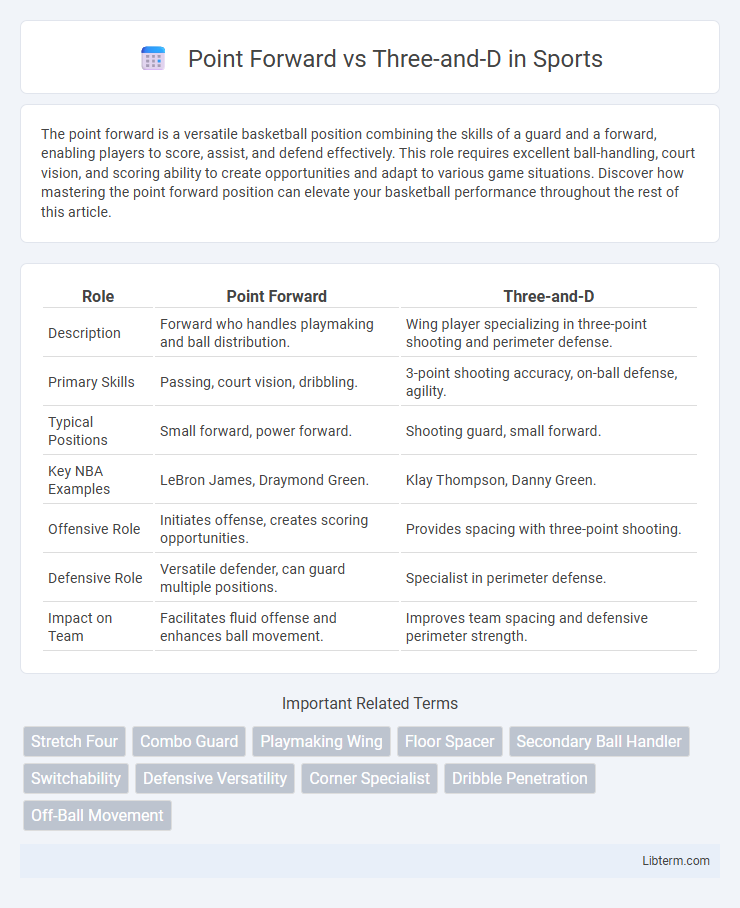The point forward is a versatile basketball position combining the skills of a guard and a forward, enabling players to score, assist, and defend effectively. This role requires excellent ball-handling, court vision, and scoring ability to create opportunities and adapt to various game situations. Discover how mastering the point forward position can elevate your basketball performance throughout the rest of this article.
Table of Comparison
| Role | Point Forward | Three-and-D |
|---|---|---|
| Description | Forward who handles playmaking and ball distribution. | Wing player specializing in three-point shooting and perimeter defense. |
| Primary Skills | Passing, court vision, dribbling. | 3-point shooting accuracy, on-ball defense, agility. |
| Typical Positions | Small forward, power forward. | Shooting guard, small forward. |
| Key NBA Examples | LeBron James, Draymond Green. | Klay Thompson, Danny Green. |
| Offensive Role | Initiates offense, creates scoring opportunities. | Provides spacing with three-point shooting. |
| Defensive Role | Versatile defender, can guard multiple positions. | Specialist in perimeter defense. |
| Impact on Team | Facilitates fluid offense and enhances ball movement. | Improves team spacing and defensive perimeter strength. |
Understanding the Point Forward Role
The point forward is a versatile basketball position combining the skills of a point guard and a forward, emphasizing playmaking, ball handling, and court vision. Unlike the traditional three-and-D role, which prioritizes perimeter shooting and defensive specialization, the point forward initiates offense, creates scoring opportunities, and controls game tempo. Understanding the point forward role highlights its strategic value in facilitating dynamic offensive schemes and enhancing team ball movement.
Defining the Three-and-D Player
A Three-and-D player specializes in three-point shooting combined with elite perimeter defense, making them invaluable for spacing the floor and disrupting opposing scorers. Unlike a point forward, who primarily initiates offense and facilitates playmaking, a Three-and-D player's role centers on catch-and-shoot opportunities and lockdown defense. This specialization impacts team dynamics by balancing offensive floor spacing with defensive versatility, optimizing both scoring efficiency and defensive pressure.
Core Skills: Playmaking vs Shooting and Defense
Point forwards excel in playmaking skills, often serving as primary ball handlers who create scoring opportunities through vision and passing. Three-and-D players specialize in perimeter shooting and defensive prowess, consistently knocking down three-point shots while guarding opposing shooters effectively. Both roles demand distinct core abilities: point forwards prioritize court awareness and distribution, whereas three-and-D players emphasize catch-and-shoot accuracy and versatile defense.
Evolution of Positions in Modern Basketball
The point forward role has evolved as versatile forwards like LeBron James and Draymond Green initiate offense with playmaking and ball-handling, blurring traditional positional boundaries. In contrast, the three-and-D player primarily emphasizes perimeter shooting and defensive prowess, specializing in spacing the floor and guarding multiple positions. Modern basketball trends highlight a shift towards multifunctional players who combine scoring, defense, and playmaking skills, reflecting the fluidity and strategic complexity of contemporary team dynamics.
Impact on Team Offense Strategies
Point forwards enhance team offense strategies by providing versatile playmaking and facilitating floor spacing through their ability to handle the ball and create scoring opportunities. Three-and-D players improve offensive efficiency by stretching the defense with consistent perimeter shooting while simultaneously contributing to defensive stops, allowing for more dynamic transition plays. Integrating both roles diversifies offensive schemes, balancing skill sets to exploit mismatches and optimize scoring potential.
Defensive Responsibilities and Matchups
Point forwards often take on versatile defensive responsibilities, frequently guarding multiple positions due to their size and agility, which demands adaptability in switching and help defense. Three-and-D players specialize in perimeter defense, primarily tasked with containing opposing shooters and maintaining close pressure on the ball handler to disrupt shooting rhythm. Defensive matchups for point forwards typically involve handling both guards and small forwards, while three-and-D specialists focus on locking down elite wing shooters and staying attached through screens.
Notable Point Forwards in NBA History
Notable point forwards in NBA history such as LeBron James, Scottie Pippen, and Draymond Green redefined the role by combining playmaking abilities with forward responsibilities, enabling versatile offensive schemes. These players excelled at distributing the ball, initiating plays, and defending multiple positions, unlike traditional three-and-D players who primarily focus on perimeter shooting and lockdown defense. The evolution of the point forward position underscores the strategic shift toward positionless basketball, highlighting versatility and all-around skill sets.
Iconic Three-and-D Players
Iconic Three-and-D players like Klay Thompson and Danny Green revolutionized NBA defenses with their elite perimeter shooting and lockdown defense, effectively stretching floor spacing and reducing driving lanes. Unlike traditional point forwards who primarily create plays and facilitate offense, these Three-and-D specialists prioritize spacing the floor through efficient three-point shooting while specializing in defensive versatility. This archetype's impact is reflected in advanced metrics like Defensive Win Shares and effective field goal percentage, highlighting their crucial role in modern NBA team dynamics.
Value and Versatility in Today’s Game
Point forwards offer exceptional versatility by seamlessly combining ball-handling, playmaking, and scoring abilities, effectively bridging the traditional roles of guards and forwards. Three-and-D players excel by providing crucial perimeter shooting and elite perimeter defense, enhancing floor spacing and defensive stability. Teams that integrate both skill sets maximize offensive options and defensive adaptability, creating a dynamic approach that thrives in today's pace-and-space basketball era.
Comparing Roles: Which Suits Your Team?
Point forwards blend playmaking and scoring, creating versatile offensive options by handling the ball and initiating plays, thus fitting teams needing dynamic ball distribution and scoring depth. Three-and-D players specialize in perimeter shooting and defense, ideal for teams emphasizing spacing and locking down opposing perimeter threats. Choosing between them depends on your team's need for primary playmaking versatility versus specialized shooting and defensive prowess.
Point Forward Infographic

 libterm.com
libterm.com